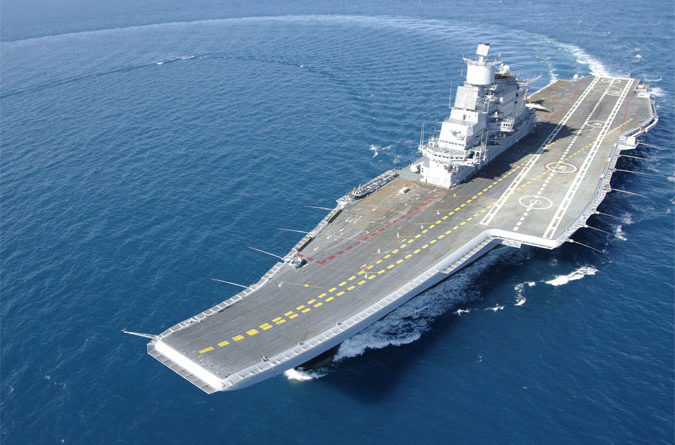Navy Chief – ‘Money Spent On Indigenous Aircraft Carrier No Waste; Need Airpower Now’
15 Oct 2021
Admiral Karambir Singh, India’s Navy Chief, has responded to those who have opposed the building of a second indigenous aircraft carrier (IAC) on the grounds that it is too expensive. In an exclusive interview with CNN-News18, he said that the “money spent on the IAC does not go down the drain”. IAC Vikrant, which is currently undergoing sea trials, is 76 per cent indigenous, made of Indian steel, and has created an ecosystem of 550 Indian firms that includes 100 MSMEs, the Navy Chief pointed out. “Projects like the indigenous aircraft carrier plough back money into the local economy and create jobs. This is not money going down the drain,” he said.

The Indian Navy currently operates one aircraft carrier, INS Vikramaditya, which currently is under maintenance. It is 40 years old. The second, IAC Vikrant, which cost around Rs 19,500 crore, will be commissioned by mid-2022. The Navy has been pitching for a third aircraft carrier (IAC-2) so that it has at least one each for the eastern and western seaboard even if one is off duty for repairs. When it comes to estimated cost, IAC-2, affectionately called Vishal, lives up to its name, with a price tag of about Rs 80,000-90,000 crore.
Chief of Defence Staff (CDS) General Bipin Rawat, the man who holds the purse strings for defence acquisition, has taken the wind out of the sails on the Navy’s plans for a third aircraft carrier. Throwing a budget boulder, he has argued that “unsinkable assets” like the Andaman & Nicobar islands should be developed instead to strengthen India’s maritime capabilities.
The Navy Chief begs to differ.
“Airpower is extremely crucial at sea. You need airpower here and now. We cannot have a Navy tethered to the shore waiting for some shore-based aircraft to support us. Aircraft carriers are crucial to the maritime concept of operations,” Admiral Karambir Singh said.
To elaborate on what the Navy Chief is saying, given the vastness of the Indian Ocean Region (IOR), even if one were to activate a group of fighters from Port Blair as soon as a threat is detected, it would take at least 90 minutes to get to the ‘spot’. And a lot can happen over 90 minutes. An aircraft carrier provides speed and flexibility, argues the Navy.
A total of 41 aircraft carriers are operated by 13 navies across the world. The United States has 11. China currently has 2 but its expansion plan is ambitious. It is aiming for 4 by 2028 and 10 by 2050, adding more airpower to what is already the largest navy in the world.
About 85 per cent of China’s energy requirement flows through the IOR. The Chinese have been regularly deploying 3-4 warships and submarines in the region in the garb of anti-piracy missions to protect their trade. Maritime security experts say it is only a matter of time before the People’s Liberation Army Navy (PLAN) replaces this ‘task force’ with a carrier battle group in the IOR.
When asked if the Indian Navy’s expansion plans are based on the Chinese threat, Admiral Singh said, “In the Navy, you have to think long term. Our expansion is completely built around the ‘Maritime Capabilities Perspective Plan’. We plan for capabilities that are needed to protect our maritime interests. Challenges that come in have a bearing but since you have to think long term, and challenges keep changing, so you have to plan based on capability rather than focusing too much on the threats.”
Courtesy: News18Editors Note:
Recent reports indicate that France is building another aircraft carrier, Japan is converting two of its largest ships into aircraft carriers. Increasingly the need to have air power at sea is felt by navies all over the world. To deny the Nave a third carrier is confused thinking. The CDS would do well to update his thought process so far as maritime needs of the country are concerned. Apart from the time factor it is also a fact that the IAF is not used to flying over waterin a combat role.

